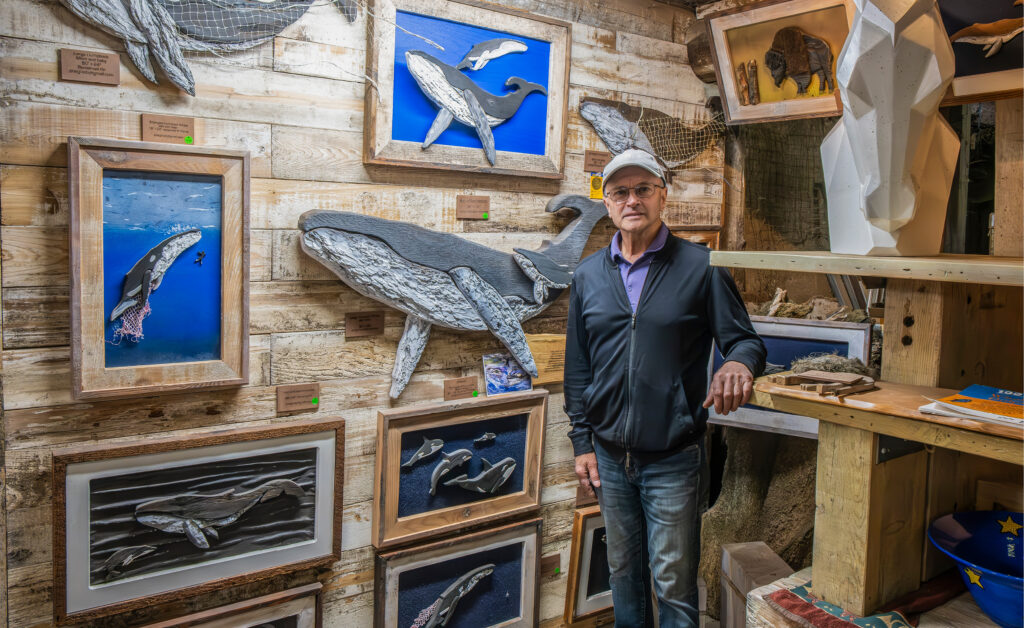by Jo Barnes | photos by Tanya Murchie –
These days, Craig Toby works with wood to construct evocative works of art depicting whales, which is a far cry from the decades he spent constructing commercial buildings.
The North Saanich wood sculptor retired from commercial construction in 2005, and since then has been working with wood in a variety of ways, most recently, to create art pieces depicting whales of the Pacific Northwest. “In construction, I had to follow blueprints and was constricted by the details of those plans,” shares Craig. “Now I have the freedom of creativity. I can make what I want to make. Through my interest in orcas and humpback whales, I’ve become acutely aware of the challenges they face. I’m using my wood art as a platform to raise consciousness about their plight.”
Craig has been a fishing enthusiast since he was a young boy. Born in Victoria, he spent countless hours fishing on the West Coast where he had the opportunity to see marine life up close. “When I was about 17, my cousin was visiting, and we went fishing in Pedder Bay,” says Craig. “We had put out our lines in the water when over 30 killer whales swam under our fishing lines. Some were about eight feet from our boat. They are so intelligent, these creatures; they didn’t bother us.”
These types of encounters had an impact and sparked Craig’s love of these animals which now inspires him in his art. His previous woodworking projects provided an opportunity to develop his skills and creativity. “After retirement, I transitioned to crafting furniture from reclaimed Vancouver Island first growth fir at my workshop,” he says. “About eight years ago, I ventured into creating charcuterie boards from maple wood, eventually shaping them into forms resembling whales.”
Craig likes the fact that sources of wood for his art are not only readily available, but they also provide a fascinating link to the past. “Over the years, I have bought lots of reclaimed turn-of-the-century wood,” comments Craig. For instance, I have pieces from a building in Chinatown dated back to 1908. Some of the reclaimed wood I have still has square nails in it from the late 1800s.”
His 1,000-square-foot workshop houses an extensive inventory of equipment including table saws, horizontal belt sanders, planers and lasers, making it an ideal space to create his art. To begin the process, Craig chooses wood for its patterns, colours, textures and shapes, keeping in mind the features and appearance of the marine life he is portraying.
“I first try to determine what the wood is saying to me. I look at the original patterns and shape of the wood,” Craig relates. “For example, I usually use a knot in the wood to portray an animal’s eye socket. For the whale’s baleen (filter feeding system in whale’s mouth), I use cedar bark because of the striations in it.”
Craig cuts the wood according to the patterns he has designed, and mounts the pieces together using a variety of special glues. His art pieces vary in size from smaller framed ones that are 16 inches to five-foot-wide freestanding creations. To replicate the actual details of some whales, Craig uses other techniques and materials. “I use white stain for the white of the killer whale. Using a tiger torch, I burn the wood to create the black colour of the whale,” he notes.
His art is increasingly being seen and appreciated. “It’s basically word of mouth,” says Craig. “The first artwork I sold is now in Portugal, and I also sold a large piece to someone who is in the Gulf Islands.”
This October Craig’s works will be on exhibit at the ArtSea Gallery. For details, visit www.artsea.ca. His recent entry in the SPAC (Saanich Peninsula Arts and Crafts) Art Show, of a humpback whale entangled in a fishing net, received a Juror’s Award for “conception, procedure and uniqueness.” For Craig, the recognition is affirming, but it’s the responses by art show attendees that mean the most. “Some people at the art show would stop and look at my art. Others would stay for a while and keep looking at it. Some would cry,” he shares.
It’s this kind of impact that feeds Craig’s desire to continue to raise awareness about the whale. While he enjoys working with wood and sharing his love of these marine animals, he is spurred on by the desire to leave a legacy. “I’m emotionally committed to these animals and I want to bring awareness of the plight of this species,” he comments. “I’d like to leave a legacy, a footprint of something I have done.”
Craig is still building with his hands, but he’s also creating from his heart with the hope of reaching others. It’s art with a social conscience.




